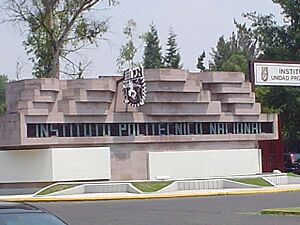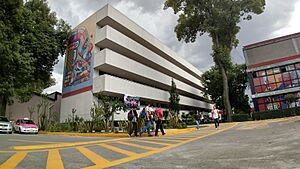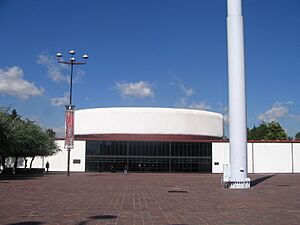Instituto Politécnico Nacional facts for kids
|
Instituto Politécnico Nacional
|
|

Official Seal
|
|
| Motto | La Técnica al Servicio de la Patria |
|---|---|
|
Motto in English
|
The Technique at the Service of the Fatherland |
| Type | Public |
| Established | 1 January 1936 |
| Founder | Juan de Dios Bátiz Paredes and Lázaro Cárdenas del Río |
|
Academic affiliations
|
AMECYD, ANUIES, AUIP, CLARA, COMEPO, CUDI, ECOES, OUI, UDUAL, Universia |
| Director | Arturo Reyes Sandoval |
|
Academic staff
|
16,445 (as of 2022) |
|
Administrative staff
|
9,144 (as of 2022) |
| Students | 216,274 (as of 2022) |
| Undergraduates | 135,558 (as of 2022) |
| Postgraduates | 6,282 (as of 2022) |
|
Other students
|
74,434 (high school) (as of 2022) |
| Location |
,
Mexico
19°30′02″N 99°08′23″W / 19.50056°N 99.13972°W |
| Campus | Several across Mexico, mostly urban |
| Colors | Maroon and white |
| Nickname | Burros Blancos |
|
Sporting affiliations
|
ONEFA Central Conference |
| Mascot | White donkey |
The National Polytechnic Institute (Spanish: Instituto Politécnico Nacional), often called IPN, is one of Mexico's largest public universities. It has many students, from high school to advanced university levels. It is known as a top university in Mexico for engineering and technical studies.
IPN was started on January 1, 1936, by President Lázaro Cárdenas. The institute has 98 different schools and centers. They offer 290 study programs. These include 57 technical careers, 79 undergraduate degrees, and 154 postgraduate programs. Its main campus is called 'Unidad Profesional Adolfo López Mateos' or 'Zacatenco'. It is in northern Mexico City and covers about 530 acres (2.1 km²).
While IPN is mainly in Mexico City, it also has research centers and facilities in 22 other states across Mexico.
Contents
History of IPN
The National Polytechnic Institute began on January 1, 1936. It was founded during the time President Lázaro Cárdenas was in charge. The land where it was built used to be a large estate called Ex hacienda Santo Tomás. This estate was first owned by the Spanish conqueror Hernán Cortés in the 1500s. The Mexican government later gave this land for the institute.
Important people who helped start IPN include the astronomer Luis Enrique Erro, former revolutionary Juan de Dios Bátiz Paredes, and former education minister Narciso Bassols. Later, during the time of director Alejo Peralta, IPN received more land. This land came from areas called Santa Maria Ticomán and San Pedro Zacatenco.
Building the main campus, known as the Professional Unit "Adolfo López Mateos" (Zacatenco), started in 1958. In 1959, former President Adolfo López Mateos and other officials opened the first four buildings. These buildings were used by the Superior School of Mechanical and Electrical Engineering (ESIME) and the Superior School of Engineering and Architecture (ESIA).
How IPN is Organized
The institute is made up of 98 different academic places. These include 18 vocational high schools, which are called CECyTs. There are also 26 university colleges and 20 centers for scientific and technical research. IPN also has centers for continuing education and units that support learning and new ideas.
Most of these schools are in Mexico City. However, some branches and research centers are spread out in 22 other states. Some parts of IPN, like the internationally known CINVESTAV, have a lot of freedom in how they operate. The whole institute is led by a director-general. This person is chosen by the President of Mexico.
Besides its schools, IPN also runs 'Canal Once' ('Channel Eleven'). This is the oldest public TV channel in Latin America. It shows cultural, scientific, and news programs. It also broadcasts foreign shows and classic movies.
What Students Can Study
IPN offers 80 different programs for undergraduate students. These programs usually take four or five years to complete and lead to a bachelor's degree. For students who want to study even more, there are 135 postgraduate programs. These include 29 postgraduate diplomas, 70 master's degrees, and 36 doctorate degrees.
Like many public universities in Mexico, IPN also has several vocational high schools. These are called 'Centros de Estudios Científicos y Tecnológicos' (C.E.C. y T.). Most of them are in the Greater Mexico City area. After finishing these schools, students can earn a technician degree. IPN offers 78 different technical careers at this level.
Sports at IPN
IPN has 27 different sports teams and activities. These include sports like archery, American football, track and field, baseball, basketball, boxing, chess, cycling, soccer, swimming, volleyball, and wrestling.
The university has a strong rivalry with the sports teams from the National Autonomous University of Mexico (UNAM). There is a particularly intense competition in football against UNAM's team, the "Pumas Dorados".
Notable People from IPN
Famous Alumni
Scientists and Innovators
- Guillermo González Camarena: A pioneer in television who invented an early system for color television.
- Jerzy Rzedowski: A plant scientist known for his work on plants in tropical areas.
- Esther Orozco: A biology researcher who won awards for her work on a disease called amoebiasis.
- Evangelina Villegas: A biochemist who won the World Food Prize for her work with maize (corn), which helped create a special type of corn with better protein.
- Pablo Rudomín: A neuroscientist who won the Prince of Asturias Award.
- Gilberto Calvillo Vives: The president of the United Nations' Statistics Commission.
- Ruth Rivera Marin: An architect and the first woman to study architecture at IPN's College of Engineering and Architecture.
- Constantino Reyes-Valerio: A chemist and art historian who discovered how to make Maya blue paint.
- Raúl Rojas: A professor of computer science and mathematics, known for his work in artificial intelligence.
Politicians
- Ernesto Zedillo: A former President of Mexico (1994-2000).
- Josefina Vázquez Mota: A former Secretary of Education in Mexico.
- Reyes Tamez: Served as Secretary of Education.
- Victor Bravo Ahuja: Served as Secretary of Education.
- Eugenio Méndez Docurro: Served as Secretary of Communications and Transportation.
- Héctor Mayagoitia Domínguez: A former Governor of Durango.
- Miguel Borge Martín: A former Governor of Quintana Roo.
- Roberto Kobeh González: Served as President of the ICAO Council.
- Luis Montes de Oca: A former Secretary of Finance in Mexico.
Notable Teachers
- Alexander Balankin: A scientist who won the UNESCO Science Prize for his work on fractal mechanics.
- Heberto Castillo: An inventor and founder of several political parties.
- Juan O'Gorman: A famous architect and painter.
- Arturo Rosenblueth: A physician and researcher in physiology.
See also
 In Spanish: Instituto Politécnico Nacional para niños
In Spanish: Instituto Politécnico Nacional para niños
- National Polytechnic Institute College of Engineering and Physical-Mathematic Sciences
- National Polytechnic Institute College of Biomedical Sciences
- National Polytechnic Institute College of Social and Administrative Sciences
- National Polytechnic Institute College of Interdisciplinary Studies







